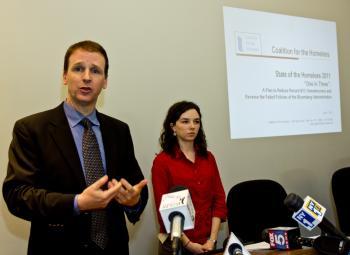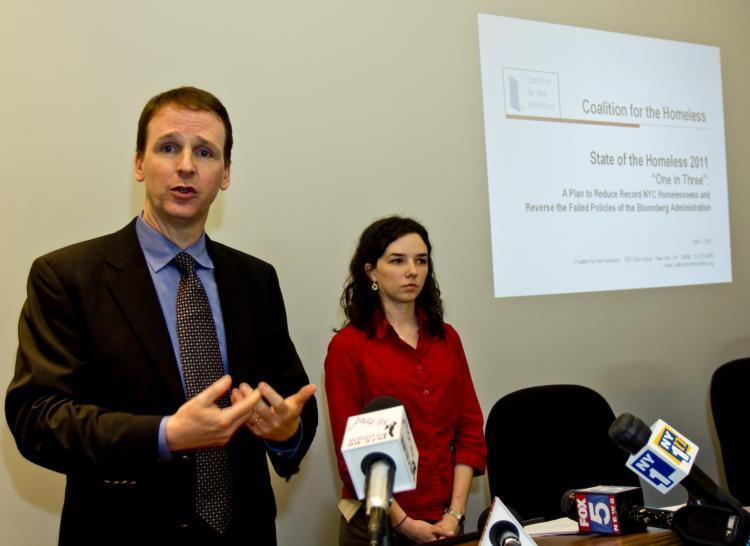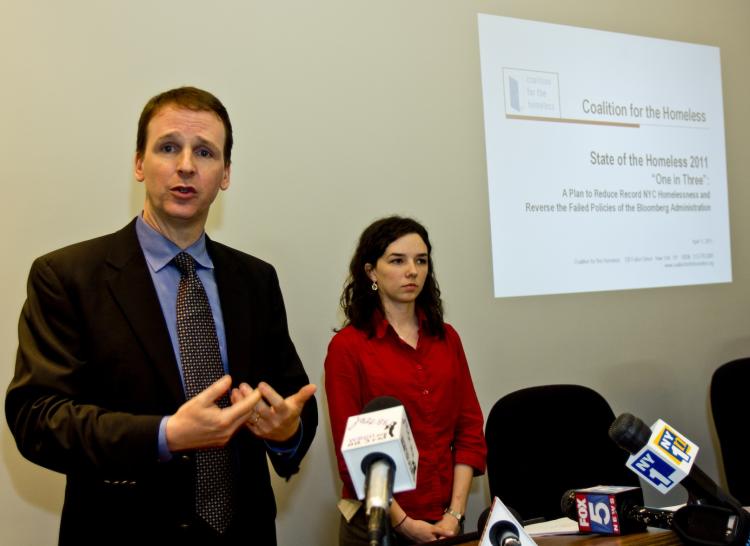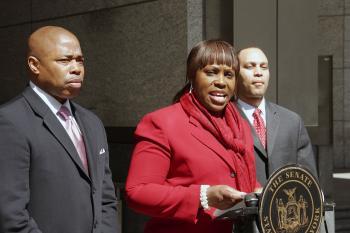NEW YORK—A record high number of New Yorkers sought refuge at the city’s homeless shelters last year, according to the Coalition for the Homeless (CFTH) 2011 annual report released on Monday.
More New Yorkers experienced homelessness than any time since the city began keeping records and since the Great Depression of the 1930s, said Patrick Markee, CFTH’s senior policy analyst.
The highest recorded single night census of homeless adults and children in the city shelter system was 39,542 people at the end of last February.
In the fiscal year ending June 30, 2010, 113,553 homeless New Yorkers, including 42,888 children, slept in public homeless shelters. This is an 8 percent increase from the previous year, a 37 percent rise since Mayor Bloomberg took office, according to the report.
The report cited high unemployment, economic recession, and the steady loss of affordable housing in the past decade as some of the reasons for the city’s homeless problem.
“But a big part of this problem is created by the failed policies of the current [Bloomberg] administration,” said Markee.
The report claims that Mayor Michael Bloomberg refused to use proven and cost-effective federal housing programs to move homeless families from shelters to stable homes and instead had implemented untested, time-limited subsidies such as the Advantage program.
According to the coalition report, the flawed time-limited subsidies have forced thousands of previously homeless families with children back into the shelter system and homelessness, costing city taxpayers $370 million in shelter costs.
“The time-limited subsidies are not only not working for the families but they are driving up the shelter census and contributing to the record high homelessness,” said Giselle Routhier, CFTH policy analyst.
Before the mayor’s time-limited subsidies, one in four families (25 percent) entering the public shelter system was previously homeless. Under Bloomberg administration, nearly double the number of homeless families seeking the city’s shelter each year were previously homeless, stated the report.
“As October of this year, I will no longer have Advantage. And I am nervous, I am worried,” said Viviana Torres, 40, a previously homeless single mother, living with her 11-year-old son in Cypress Hills, Brooklyn.
Like others in the same plight, Torres was unsure of her future.
“We could end up back in the shelter, which I really don’t want. The mayor needs to care about us too. I hope something happens soon, so I don’t become one of the statistics,” said Torres.
The report proposed that the Bloomberg administration return to the “one in three” policy implemented by previous mayors. This policy allocated one out of three public housing vacancies and one out of three Section 8 vouchers to homeless families.
“What we call for is to use a portion of the federal housing resources that include public housing and Section 8 vouchers; to use them to get families out of shelter and into permanent housing,” said Routhier.
Using the federal housing resource is more effective and saves the city taxpayers’ dollars, explained Routhier.
“Their [CFTH’s] reliance on federal subsidies is totally unrealistic,” said Seth Diamond, Commissioner at the New York City Department of Homeless Services.
The city cannot look to Washington to solve its homeless problem, stated Diamond.
“There is a waiting list of over 100,000. [Washington] is not even able to take applications. That situation will only get more difficult based on the budget discussions going on in Washington,” said Diamond.
Instead, the city’s department of homeless services focuses on supporting people in shelter who are working. “And that has proven to be an important and successful part of our program,” said Diamond.
When contacted about the report, Diamond commented that, “it is a distorted look at the data.”
“A fair way to look at it would acknowledge that the number families with children in the system are down nearly 4 percent compared to a year ago,” said Diamond.
More New Yorkers experienced homelessness than any time since the city began keeping records and since the Great Depression of the 1930s, said Patrick Markee, CFTH’s senior policy analyst.
The highest recorded single night census of homeless adults and children in the city shelter system was 39,542 people at the end of last February.
In the fiscal year ending June 30, 2010, 113,553 homeless New Yorkers, including 42,888 children, slept in public homeless shelters. This is an 8 percent increase from the previous year, a 37 percent rise since Mayor Bloomberg took office, according to the report.
The report cited high unemployment, economic recession, and the steady loss of affordable housing in the past decade as some of the reasons for the city’s homeless problem.
“But a big part of this problem is created by the failed policies of the current [Bloomberg] administration,” said Markee.
The report claims that Mayor Michael Bloomberg refused to use proven and cost-effective federal housing programs to move homeless families from shelters to stable homes and instead had implemented untested, time-limited subsidies such as the Advantage program.
According to the coalition report, the flawed time-limited subsidies have forced thousands of previously homeless families with children back into the shelter system and homelessness, costing city taxpayers $370 million in shelter costs.
“The time-limited subsidies are not only not working for the families but they are driving up the shelter census and contributing to the record high homelessness,” said Giselle Routhier, CFTH policy analyst.
Before the mayor’s time-limited subsidies, one in four families (25 percent) entering the public shelter system was previously homeless. Under Bloomberg administration, nearly double the number of homeless families seeking the city’s shelter each year were previously homeless, stated the report.
“As October of this year, I will no longer have Advantage. And I am nervous, I am worried,” said Viviana Torres, 40, a previously homeless single mother, living with her 11-year-old son in Cypress Hills, Brooklyn.
Like others in the same plight, Torres was unsure of her future.
“We could end up back in the shelter, which I really don’t want. The mayor needs to care about us too. I hope something happens soon, so I don’t become one of the statistics,” said Torres.
The report proposed that the Bloomberg administration return to the “one in three” policy implemented by previous mayors. This policy allocated one out of three public housing vacancies and one out of three Section 8 vouchers to homeless families.
“What we call for is to use a portion of the federal housing resources that include public housing and Section 8 vouchers; to use them to get families out of shelter and into permanent housing,” said Routhier.
Using the federal housing resource is more effective and saves the city taxpayers’ dollars, explained Routhier.
“Their [CFTH’s] reliance on federal subsidies is totally unrealistic,” said Seth Diamond, Commissioner at the New York City Department of Homeless Services.
The city cannot look to Washington to solve its homeless problem, stated Diamond.
“There is a waiting list of over 100,000. [Washington] is not even able to take applications. That situation will only get more difficult based on the budget discussions going on in Washington,” said Diamond.
Instead, the city’s department of homeless services focuses on supporting people in shelter who are working. “And that has proven to be an important and successful part of our program,” said Diamond.
When contacted about the report, Diamond commented that, “it is a distorted look at the data.”
“A fair way to look at it would acknowledge that the number families with children in the system are down nearly 4 percent compared to a year ago,” said Diamond.







Friends Read Free